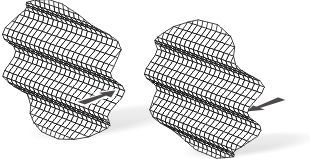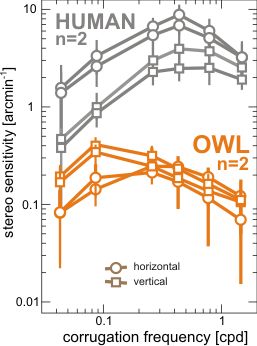[Disparity sensitivity] [Absolute sensitivity]



| [Owl Cam] [Ocular aberrations] [Contrast sensitivity] [Vernier acuity] [Disparity sensitivity] [Absolute sensitivity] |
|||||||||||
|
|
|||||||||||
| Computing shape from stereo: the DSF | |||||||||||
| project completed | |||||||||||
| download: [poster] [paper] | |||||||||||
 |
|||||||||||
 |
|||||||||||
 |
|||||||||||
| If you free fuse the two random dot patches shown above (by either convergent or divergent fusion), you will perceive a corrugation in depth, similar as the one shown to the right. It is your brain that detects tiny positional differences in the left and right dot matrices, and these differences (called horizontal disparities) are interpreted as differences in depth, that give finally rise to the (illusionary) percept of a continuous, corrugated surface. | |||||||||||
| There are however differences in how sensitive the brain is to detect the disparities with respect to the spatial frequencies of the depth corrugation they define. Intermediate frequencies are detected best, the detection of both lower and higher frequencies is reduced. This relation constitutes the so called disparity sensitivity function (DSF), shown here at the right panel. | |||||||||||
| So far, the DSF was only demonstrated with human subjects. Our project aims to describe the DSF in another animal with global stereospis, the barn owl. The results implicate that barn owls compute shape from stereo similar as humans do. A comparison to the respective sensitivity function in the luminance domain (CSF) reveals particular symmetries across species and modalities. | |||||||||||